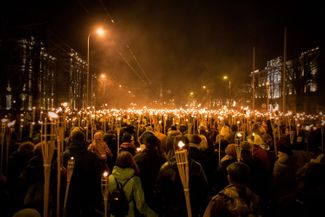Last December, three Latvian political parties came together to form a new government. The coalition negotiations had dragged on for more than two months. During the elections in October, incumbent Prime Minister Krišjānis Kariņš’s center-right New Unity party came out on top with 19 percent of the vote. Analysts argued that Latvians sought continuity amid the fallout from Russia’s war against Ukraine. Support for some parties espousing Euroskeptic and anti-NATO platforms simply collapsed, and Russian-speakers scattered their votes among various political groupings, leaving the once-popular Harmony — a purportedly center-left party representing Latvia’s Russian-speaking minority — out in the cold. As it happened, right-of-center parties weren’t the only beneficiaries of these shifts: the Progressives, a social-democratic green party, passed the five-percent electoral threshold for the first time and scooped up 10 parliamentary seats. For the Beet, Deep Baltic editor Will Mawhood recounts how the Progressives’ slow but steady rise has shaken up Latvia’s long-standing political divisions.
“We are polar bears and the Progressives are penguins — in the wild their paths essentially don’t cross,” Rihards Kols, a parliamentarian from the National Alliance party told Latvian television the morning after the country’s parliamentary elections last October. Seemingly pleased with his party’s fourth-place showing and his zoological metaphor (repeated from the night before), Kols was setting out a series of “red lines.” Namely, the political forces with which the nationalist party would refuse to form a governing coalition. In addition to the anti-sanctions party For Stability! and two groupings backed by oligarchs with questionable business and political ties, Kols listed newcomers the Progressives (Progresīvie, in Latvian).
The red lines Kols referred to have been a constant feature of post-election chatter in Latvia in recent decades. Principles such as Latvian as the sole state language and a Western-aligned geopolitical orientation (and, more recently, unambiguous support for Ukraine) are non-negotiable for many, if not most, Latvian voters. As such, parties with a hostile or ambiguous stance on these issues, including most parties popular with the country’s russophone minority, have been excluded from coalition talks. Coalitions are typically cobbled together from so-called “Latvian” parties, but they’re often stretched and conceptually loose.
Kols’ National Alliance is an umbrella party that can trace its roots back to the late 1980s and more radical, exclusionary sections of the movement to restore Latvia’s independence, supplemented by newer nationalist contenders. Reliably hostile to the Kremlin, it has been part of every coalition government since 2011. Describing the National Alliance as a “radical right populist” party, Latvian political scientist Daunis Auers observes that they have proved a surprisingly undemanding coalition partner for their more mainstream colleagues on many issues, while carving out a fiefdom in the Culture Ministry and frustrating Latvia’s ratification of the Council of Europe Convention on Preventing and Combating Violence Against Women and Domestic Violence, better known as the Istanbul Convention.
Shortly after Kols, Progressives prime ministerial candidate Kaspars Briškens gave an interview in the same verdant park just outside of Riga’s Old Town. He set out almost identical red lines, although he didn’t rule out working with the National Alliance. It was difficult not to notice, as a parallel feed showed scenes of celebration from the night before at the respective parties’ HQs, that the crowd carousing along with the Progressives looked quite a bit younger.
‘Something liberal and leftist’
The Progressives’ blurb on all of their social media accounts declares, “For justice, freedom, equality, and solidarity in an environmentally friendly Latvia.” Founded as a social-democratic NGO in 2011, it registered as a political party six years later, attempting to bring socially liberal arguments to a political landscape that at that time looked singularly unwelcoming (in 2017, this author penned a lengthy article titled simply “What Became of Latvia’s Left?”). In 2020, the Progressives were the largest entity in an alliance of left and liberal forces that took power in municipal elections in Riga, replacing scandal-hit Harmony, traditionally the most popular party with Latvia’s russophone minority by far.
Una Bergmane, a Latvian historian based at the University of Helsinki, describes the Progressives as “the first modern, green, left-wing party” to be elected to parliament (the Saeima) since the restoration of Latvia’s independence in 1990. (Harmony, although primarily seen in Latvia as an advocate for the interests of Russian-speakers, also describes itself as a social democratic party. Bergmane, however, refers to its record during its decade in government in Riga as being only sporadically and opportunistically left-wing).
Bergmane attributes the Progressives’ steady rise to a younger generation in Latvia increasingly reaching voting age. “It’s a generation that has grown up completely immersed in Western European [and] American culture, media, [and] discussions — and so they are very different from people who lived in the Soviet times or even from ‘millennials,’” she tells The Beet. “[Many] issues, such as the environment, such as LGBT rights, such as a more inclusive society — these for them are questions that it’s not even necessary for them to discuss, it’s obvious.”
Polls taken in the month leading up to the election showed the Progressives as the second most popular party among Latvian-speakers between the ages of 18 and 29, and the first choice among 18- to 29-year-olds whose native language is Russian. One exemplar of the Progressives’ young voter base is Selma Levrence, who decided to run on their ticket in 2022. At 22 years old, she only became legally eligible to stand for parliament a year earlier. Primarily known in Latvia for her activism for LGBTQ+ causes and her active social media presence, Levrence says she joined the Progressives’ youth wing several years ago. “I was happy that there was something for young people — something liberal and leftist,” she recalls.
Levrence attributes the left’s lack of appeal among Latvian-speakers to history and says that if policies aren’t explicitly flagged as left-wing, they’re often popular with the public. “Before the Soviet occupation and before the war [World War II], Latvia was quite a left-wing place — in terms of social democrats and democratic socialists. But now people associate ‘left-wing’ with the Soviet Union, and of course that’s a very bad association for most people,” she explains. “So I think it’s also about a new generation of people who are kind of breaking the stigma.”
‘Latvian’ parties
Before and immediately after its establishment in 1918, the Republic of Latvia was indeed known for its radicalism. In the subsequent elections in 1920, the Latvian Social Democratic Workers Party (LSDSP) won a sweeping victory with almost 40 percent of the vote. Social democrats also exerted considerable influence on the writing of the Latvian constitution (Satversme), which was drawn up two years later and remains in force.
Compared to the LSDSP’s electoral exploits in the interwar period, topping the poll in every election held, the Progressives’ achievements last year — finishing seventh and just passing the electoral threshold with six percent of the vote — seem modest. But they’re operating in a very different context, in a country with very different demographics. And they appear to be making some progress in breaking down one of the Soviet Union’s most enduring legacies in Latvia: the existence of two parallel communities split not only by preferred language but to a large extent by worldview.
 Eurasia Press & News
Eurasia Press & News




